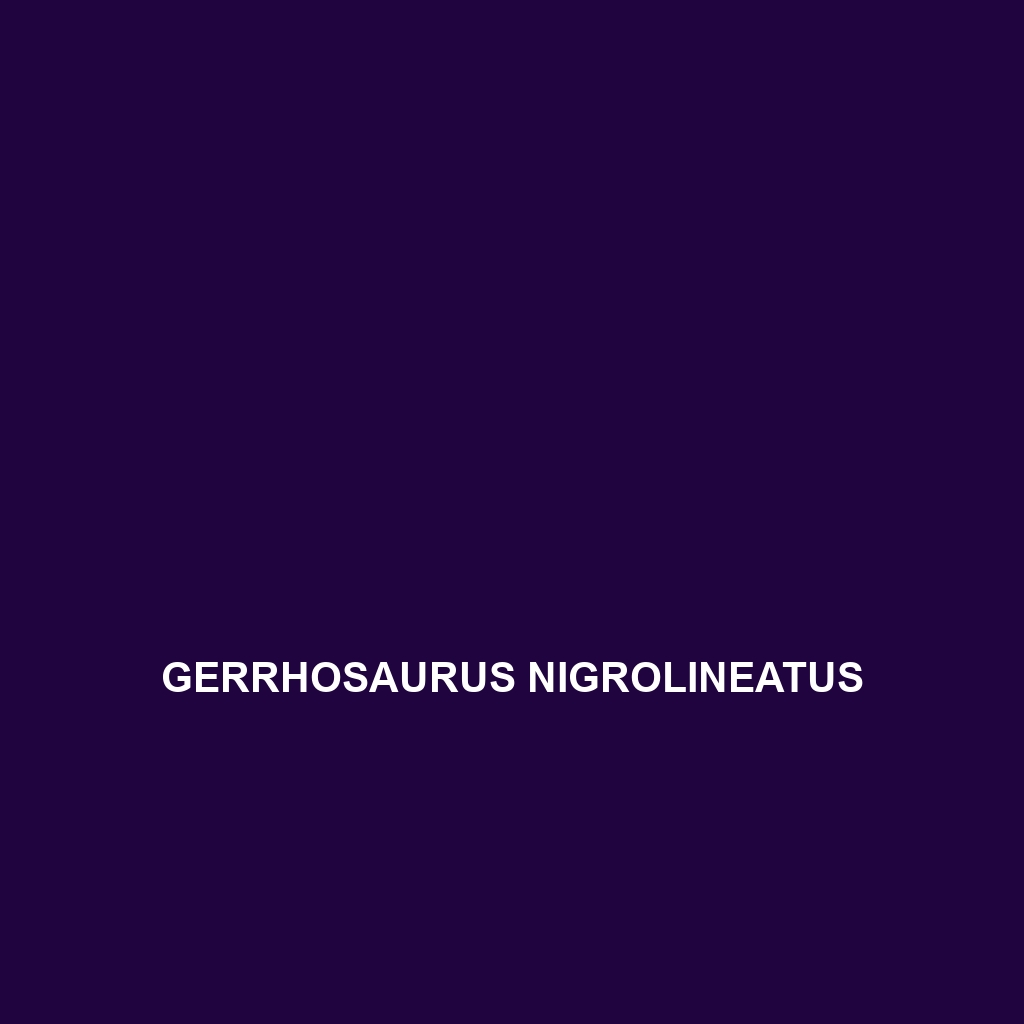Common Name
Gerrhosaurus nigrolineatus
Scientific Name
Gerrhosaurus nigrolineatus
Habitat
Gerrhosaurus nigrolineatus, commonly known as the black-lined plated lizard, is primarily found in the savanna and scrubland habitats of Southern Africa, particularly in countries like South Africa, Botswana, and Namibia. This species thrives in environments characterized by warm climates and well-drained soils, often near rocky outcrops where it can find shelter from predators. The presence of dry grasslands and scattered vegetation allows for optimal living conditions, as these habitats provide abundant hiding spots and basking areas necessary for thermoregulation. The lizard is seldom found in dense rainforests or moist temperate forests, as it prefers arid landscapes that enable its unique adaptations.
Physical Characteristics
Gerrhosaurus nigrolineatus typically exhibits a robust, elongated body that can reach lengths of up to 30 centimeters. Its striking coloration features a predominant brown or grayish body adorned with black stripes running longitudinally down its sides. These stripes provide excellent camouflage against predators in its natural habitat. The lizard’s body is covered in tough, bony scales which offer protection, while its stout limbs enable agile movements across uneven terrains. The tail is relatively long and can be used as a defensive mechanism, allowing the lizard to drop its tail when threatened by predators, a process known as autotomy. Its well-developed limbs are an adaptation allowing for quick escapes into burrows or under rocks.
Behavior
The behavior of Gerrhosaurus nigrolineatus is characterized by its diurnal activity, meaning it is primarily active during the day. This lizard is known for its territorial nature, often seen basking in the sun during the early hours before retreating into the shade as temperatures rise. Social interactions among individuals showcase a range of behaviors including displays of dominance and courtship rituals during the mating season. Notably, the species exhibits unique defense behaviors, such as puffing up its body to appear larger when threatened and retreating quickly into crevices. Migratory patterns have not been widely documented, but local movements in response to environmental changes showcase this species’ adaptability.
Diet
Gerrhosaurus nigrolineatus is predominantly an omnivore, showcasing a varied diet that includes insects, small invertebrates, and plant matter. Its feeding habits are influenced by seasonal availability, with a particular preference for leafy greens, fruits, and flowers during the rainy season when food sources are abundant. The lizard employs a foraging strategy that allows it to optimize its energy intake, utilizing both active hunting and opportunistic feeding. This adaptability in diet plays a crucial role in its survival across different environments, allowing it to flourish in nutrient-poor habitats.
Reproduction
The reproductive cycle of Gerrhosaurus nigrolineatus typically occurs during the warmer months, with mating season occurring in the spring. Following a courtship display, females will lay a clutch of 4 to 10 eggs in a concealed location, which may include sandy soil or under rocks. The gestation period for these eggs is approximately 60 to 80 days, after which the hatchlings emerge looking similar to adults but on a smaller scale. Parental care is minimal post-hatching, with the young lizards becoming independent shortly after birth. The reproductive rate of this species can be affected by environmental factors, influencing population dynamics within their habitats.
Conservation Status
According to the International Union for Conservation of Nature (IUCN), Gerrhosaurus nigrolineatus is classified as having a conservation status of ‘Least Concern’. While currently not facing significant threats, habitat destruction due to agricultural expansion and urban development poses potential risks to future populations. Conservation efforts focus on habitat management and preservation, ensuring the sustainability of their environments. Continuous monitoring is essential to assess any emerging threats and address conservation challenges.
Interesting Facts
One fascinating aspect of Gerrhosaurus nigrolineatus is its ability to perform autotomy, which aids in escaping from predators. Furthermore, the species possesses a high level of adaptability to diverse environmental conditions, allowing it to thrive in various ecosystems across Southern Africa. Additionally, studies have shown that these lizards exhibit social behaviors, especially during the mating season, where males engage in elaborate displays to attract females.
Role in Ecosystem
Gerrhosaurus nigrolineatus plays a significant role in its ecosystem by contributing to pest control through its insectivorous feeding habits. Additionally, its foraging activities aid in seed dispersal, promoting plant growth and diversity within its habitat. As both predator and prey, the black-lined plated lizard forms an essential component of the food web, interacting with various species, from insects to larger predators. Its presence is indicative of a balanced ecosystem, highlighting the importance of maintaining healthy populations of this unique lizard.
